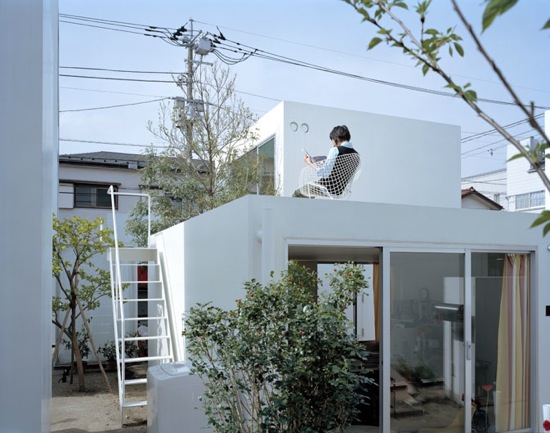Dwelling on Moriyama · Photographs by Takashi Homma & Iwan Baan, from the books Tokyo and Single Story Urbanism.

We attain to dwelling, so it seems, only by means of building. The latter, building, has the former, dwelling, as its goal. Still, not every building is a dwelling.

The Old English and High German word for building, buan, means to dwell. This signifies: to remain, to stay in place. The real meaning of the verb bauen, namely, to dwell, has been lost to us. But a covert trace of it has been preserved in the German word Nachbar, neighbour. The neighbour is in Old English the neahgebur; neah, near, and gebur, dweller.

Building and thinking are, each in their own way, inescapable for dwelling.

Only if we are capable of dwelling, only then can we build.
- Martin Heidegger, Building, Dwelling, Thinking
In my thoughts: Richard Sennett’s Corrosion of Character and Heidegger’s Building, Dwelling, Thinking interacting on the site of SANAA’s Moriyama House, Tokyo, which is arranged as a set of distinct housing components forming a network of compact structures [1] [2]. Both a contemporary expression of modularity and flexibility, as well as a play on polarities (house/garden public/private); I’m struck by how the dimensions of both street and architecture in these scenes relate so directly and intimately to the human body. These are houses, not, as in the Western suburban ideal, designed for things — our conspicuous accumulation of material possessions — but for people. Likewise the road depicted, serving not large vehicles, but instead designed for walking and cycling. Proposed here is a subversion of the suburban ideal (located as it is in the outskirts of Tokyo): an architecture for a network of individuals.
This unflinching focus on the body as a pre-requisite for a dwellable space.
See Also: Desire Path, Network
Best of the web
- Best Non Gamstop Casinos
- Non Aams Casino 2025
- Betting Sites UK
- Non Gamstop Casinos
- Casinos Not On Gamstop
- Casino Sites Not On Gamstop
- UK Casinos Not On Gamstop
- Migliori Bookmakers Non Aams
- Slots Not On Gamstop
- Non Gamstop Casino Sites UK
- Casinos Not On Gamstop
- UK Casino Not On Gamstop
- Migliori Casino Non Aams
- Casino Sites UK
- Non Gamstop Casinos
- UK Casino Not On Gamstop
- Casinos Not On Gamstop
- Online Slot Sites UK
- Casino Sites Not On Gamstop
- Non Gamstop Casinos UK
- UK Casino Sites Not On Gamstop
- Slots Not On Gamstop
- Slot Online Migliori
- Non Gamstop Casino
- Casino Crypto En Ligne
- Meilleur Casino Belgique